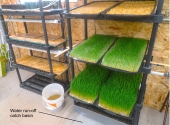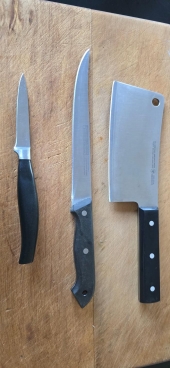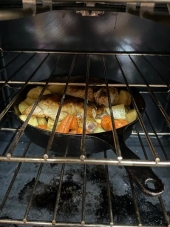As so many have said, it depends on your location and climate.
It depends on several other things too. Like:
Is this a garden we're talking about, i.e. a cleared and maintained area that will be tended at least occasionally?
Or is it landscaping, i.e. the plant life of all sizes that surround the house and make up the property?
How much labor is realistically going to go into it, and how often, at what time of year?
What is the ecosystem it's in? Forest? Prairie? Subdivision? Wildland? How much sun does it get.?
What kind of wildlife is common? Deer? Gophers? Bears? If bears are around, it will take electric fencing to protect fruit trees from being broken down.
What time of year do you visit, primarily?
As with any design problem, the best answers come from the most thorough understanding of the parameters.
Most parts of the country have a native (or naturalized) plum and a native elderberry. Probably there is also a local berry of some sort adapted to your area and not needing irrigation. If so, those are a good start for privacy screens, shelter from wind, etc. Of the European fruit trees you can buy, Quince trees are widely adapted and pest-free. In mildish climates they are a great choice, assuming you're willing to cook and/or process them. Like most hardy fruits, they don't keep. Apples also can be quite self-sustaining in my Mediterranean climate, whereas they are dependent on pest control in moister climates. Siberian Pea Shrub has proved useful in some areas, a pest in others.
If you have enough sun for vegetables and are willing to keep an area clear for them (because if you're not, weeds will lead to either grasses or woody shrubs pretty quickly) then I would suggest Perpetual Spinach,
https://www.quailseeds.com/store/p9/Perpetual_Spinach_%28Leafbeet%29_Chard.htmla very deep-rooted and long-lived type of chard. It is tall enough and deep-rooted enough to survive quite a bit of weed pressure. Other possible greens for a semi-wild garden (depending on rainfall) are Seven-Top Turnips,
https://www.quailseeds.com/store/p503/Seven_Top_Turnip_Greens_%28Cima_di_Rapa%29.html. They're grown for their long, long season of leaves and then flower buds, not their roots. (The big deep roots do make them very resilient.) Mustard greens are likewise quite able to deal with crowding and weeds as well as some frost. Chicory is a better alternative to dandelion, I think. The leaves are bigger and taller as well as staying more palatable for longer in the season. There are several cultivated varieties that range from those needing lots of care (Radicchio) to those that will survive in a meadow situation (Italian Dandelion,
https://www.quailseeds.com/store/p597/Italian_Dandelion%2C_Catalogna_Chicory.html) There is also a semi-wild perennial chicory planted in pastures
https://www.quailseeds.com/store/p473/Forage_Chicory.html. It's planted for livestock, like forage kale, but is edible by humans who don't mind strong flavors. Sorrel
https://www.quailseeds.com/store/p166/Garden_Sorrel.html is another deep-rooted leafy perennial that survives well on its own. Cilantro is widely adapted, tall enough to overtop most weeds, and self-sows readily. It is also winter hardy to zone 7 or so. Walking onions, Evergreen perennial onions,
https://www.quailseeds.com/store/p269/Evergreen_White_Bunching_Onion_%28Nebuka%29.html and any native onion you can find are all great possibilities. Elephant garlic naturalizes in mild climates as well. In the Eastern forests, Sochan is a perennial flower that produces edible greens in spring and pollinator-magnet flowers in late summer,
https://www.quailseeds.com/store/p596/Sochan%2C_Cutleaf_Coneflower.html. In the warmer zones, perennial arugula is a deep-rooted and pollinator-friendly perennial on rocky soil,
https://www.quailseeds.com/store/p295/Perennial_Arugula%2C_Rucola_selvatica%2C_Wild_Rocket_%22Sylvetta.html. Salad Burnet is hardy in most any zone--I've seen it in swamps and growing in sidewalk cracks when it was 100 degrees out.
https://www.quailseeds.com/store/p488/Salad_Burnet.html
I would stay away from anything low-growing, any of the garden brassicas (cabbage, broccoli, etc) and any of the cucurbits. While it's true that vining squash are tall and able to deal with weeds, they also need a lot of fertility and quite a bit of water in order to do anything, and are prey to many diseases. The big juicy squashes are a magnet for every wild creature from gophers to deer and raccoons. So a cabin in any kind of wild setting is not their best location without fencing and human intervention. The same is true of fruit, of course, so if you truly depend on harvesting it, measures should be taken to exclude raccoons, bears, deer, and birds, all of which are problems where I live, even with the owner in residence. Of the vining crops, groundnuts might be a good choice if you live in their zone, since the edible part is out of sight.
Unless you are committing to a garden plot that is kept clear, at least seasonally, of weeds, you would do better to think of it as landscaping and concentrate on woody plants and native shrubs. hardy perennials, and their companion annuals. An island of diversity that starts with the native ecosystem and provides habitat for ever-rarer species like native bees will provide surroundings that are beautiful, useful, and full of beneficial insects. Then, if you do end up having the time and energy for a garden plot, you will have all your pollinators and predator insects already in place, as well as a bunch of flowers, teas, herbs, basketry materials, etc. It's well worth looking into what plants the Native Americans in your area used. They had thousands of years to figure out what works.
In other words, better to plant a self-sustaining guild of native (and other harmonious) plants intentionally than to try for a bunch of edibles and end up with something like Bermuda Grass.







